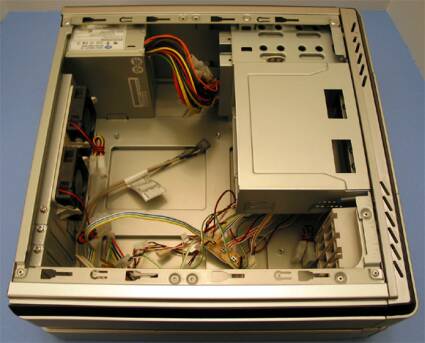2003 Winter Case Review Part 1: MicroATX Case Madness
Athenatech - ShockZ-100, Continued
The ShockZ-100 from Athenatech is quite an interesting concept. We found it to be one of the most unique designs we have seen. However, the idea of adding so many different features to the ShockZ-100 seems to have also contributed to more than a few glitches. Our sample model arrived somewhat damaged, as the switches that controlled the front functions and the LEDs had come loose and were disconnected from the front of the case. It was not a major problem to reattach these pieces, yet it was somewhat disconcerting to note these problems occurring even prior to assembly. The "ShockZ-100" name may sound a tad corny, but there is nothing corny with what this MicroATX tower attempts to deliver. The name "Shock" is molded into a smoke-colored, small window in the middle of the side panel of the case that measures 6.76 inches by 4.0 inches.
The ShockZ-100 attempts to streamline and round the edges of the case by using a variety of features to provide the appearance of a more curved and high-tech look. We found this look unique compared to other cases that are available in the MicroATX niche. The ShockZ-100 relies on a considerable amount of plastic that is mounted around its steel shell; the plastic bezel encompasses almost the entire case, except for the side panels. We greeted this design with skepticism, as we believe the use of this much plastic will impact the durability of this case. To its credit, however, the Z-100 provides an integrated, flip-down, streamlined drive bezel that covers the 5.25" CD-ROM/DVD ROM drive, so the color of the drive bezel is not an important consideration. The 3.5" bay that can be used for a floppy drive/internal media card reader is covered by a slide cover that moves back and forth to reveal a device only as needed.
A look at the inside configuration of the ShockZ-100.
The most attractive feature in the ShockZ-100 is the LCD temperature display that is integrated into the lower part of the front bezel. In order to gain access to the front of the ShockZ-100, the entire front bezel must be removed; and to remove the front bezel it must be lifted from the bottom of the ShockZ-100. This provided quite a challenge for us due to an error in the instruction manual included with the ShockZ-100. The manual indicates that bezel can be removed without removing the side panel, which is not the case. The bezel must be removed by first removing a retaining clip on the inside of the case before attempting to lift the bezel off. Failure to complete this process correctly can result in snapping off one of the bezel tabs.
Get Tom's Hardware's best news and in-depth reviews, straight to your inbox.
Current page: Athenatech - ShockZ-100, Continued
Prev Page Athenatech - ShockZ-100 Next Page Athenatech - ShockZ-100, Continued